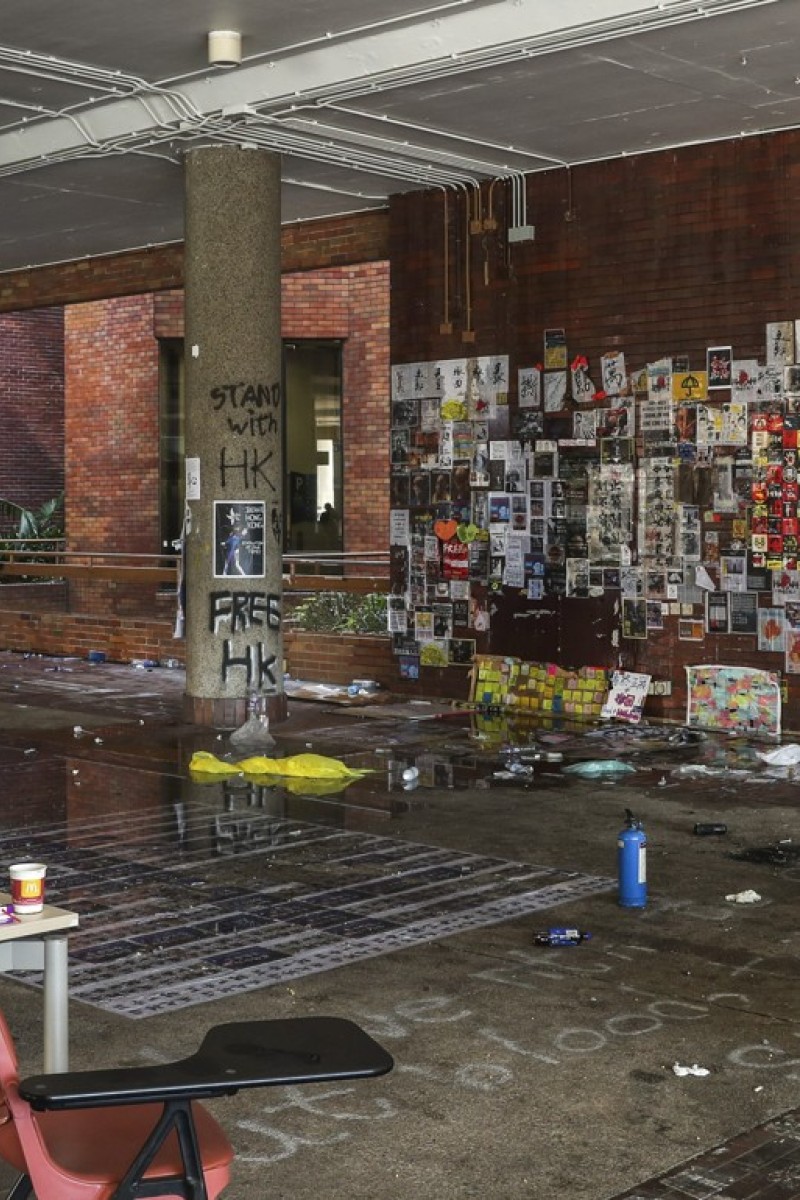
Measures are also being made to clear roadblocks outside the Cross-Harbour Tunnel, which has been shut for a week
 Damage left at the Polytechnic University in Hung Hom after most protesters have either escaped or surrendered.
Damage left at the Polytechnic University in Hung Hom after most protesters have either escaped or surrendered.Wednesday provided a rare day of calm in Hong Kong after more than a week of violence in multiple locations, including fierce clashes at Polytechnic University, where 100 protesters are still defying surrender despite repeated pleas for them to leave the campus.
While the university grounds in Hung Hom continued to be sealed off by police, with officers arresting anyone who tried to flee, the government began clearing roadblocks outside and around the Cross-Harbour Tunnel toll plaza, with plans to reopen the city’s most heavily-used tunnel soon.
Among those arrested were two young men trying to escape by climbing down a manhole into underground sewers. They emerged outside the campus, only to find police waiting for them. They were arrested for rioting, according to police. Three men and one woman who lifted the manhole cover to help them out were also arrested for assisting a crime.
Another 37 people were arrested for abseiling down a footbridge to a highway on Monday.
“I must stress that our cordons have covered all the areas concerned,” Yau Tsim District Commander Ho Yun-sing said at a Wednesday evening media briefing outside PolyU. “Those who want to escape from their responsibility will not succeed. They will only put lives in danger. I appeal to them to put down their weapons and leave [PolyU] peacefully.”
He reiterated the government’s position that the stand-off should be resolved peacefully and in a humane manner.
Police’s siege of the campus and heavy firing of tear gas in the stand-off have prompted comments of concern from foreign governments and international bodies.
Rupert Colville, the UN high commissioner for human rights, was among them. But he said the extreme violence used by some protesters against police was “deeply regrettable and cannot be condoned”, while also calling for “truly inclusive dialogue” and accountability from all sides.
Making an appeal to all engaging in protests to renounce and condemn the use of violence, he urged the Hong Kong government to “address the humanitarian situation of those inside [PolyU]” and facilitate a peaceful solution.
Anti-mask law ruled unconstitutional by Hong Kong High Court
PolyU president Teng Jin-guang, showing up on the campus for the second time since police surrounded it on Sunday evening, estimated there were about 100 protesters still inside, and about 20 of them were PolyU students.
Teng said he was not aware if police had a “deadline” for their surrender.
He also responded to criticism that he had not been proactively dealing with the crisis happening on his turf, saying he had been “working behind the scenes”.
He said the school was concerned about the presence of chemicals on campus and the deteriorating hygiene, and would make plans for a clean-up later on.
Soon after Teng spoke, a group of hundreds, led by leaders of the pro-Beijing Federation of Trade Unions, arrived in front of Hung Hom railway station with brooms, gloves and trash bags. Some marched along Hung Hom Bypass and Salisbury Road to sweep dirt and remove barricades, while others were seen taking group pictures.
Earlier in the day, other protesters appeared to have scaled back their actions compared with last week. From the start of last week, protesters had disrupted MTR services and blocked roads in a bid to force a citywide strike.
They mobilised people to join lunchtime protests at Central and elsewhere, which at times turned ugly with bricks thrown and tear gas fired, and engaged in tense stand-offs with police well into the night at multiple locations.
Students at Tuen Mun secondary school block entrance, forcing school to close
The three lunchtime protests, in Central, Kwun Tong, and Tai Koo, also ended quickly and without incident. Those in Central were prevented by dozens of police officers from walking onto the road as they did before, and most left the scene soon after.
Some secondary school students attempted to block roads on their first day back since classes were suspended last week. Around 100 students marched from Kwun Tong MTR station and disrupted traffic at a road junction before the start of class.
Another group of 50 formed a human chain outside a school in Tsuen Wan to try to stop their peers from entering. But the action ended soon after riot police arrived.
Back at PolyU, Auxiliary Bishop Joseph Ha Chi-shing, who was allowed to enter the campus to mediate and persuade protesters to surrender, said those he met were very tired and anxious. “You can see they feel helpless and frightened. They have not decided their next move,” he said.
Tom was one of them. The 23-year-old said he could not help feeling uncertain and homesick.
“We tried to get what we can get our hands on,” he said.
Demonstrators disrupt traffic and MTR services on Wednesday morning
But he was not sure how many more days the supplies could last. Despite missing his family badly, he said he was not willing to surrender as he was worried how police would treat him.
Another protester said there were about 40 people who would not give themselves up at all cost. Among them is a 12-year-old, he said.
On Wednesday evening, the last of seven first aid workers retreated from the campus, as other medical service providers, including St John’s Ambulance, were allowed in to help, along with volunteer doctors.